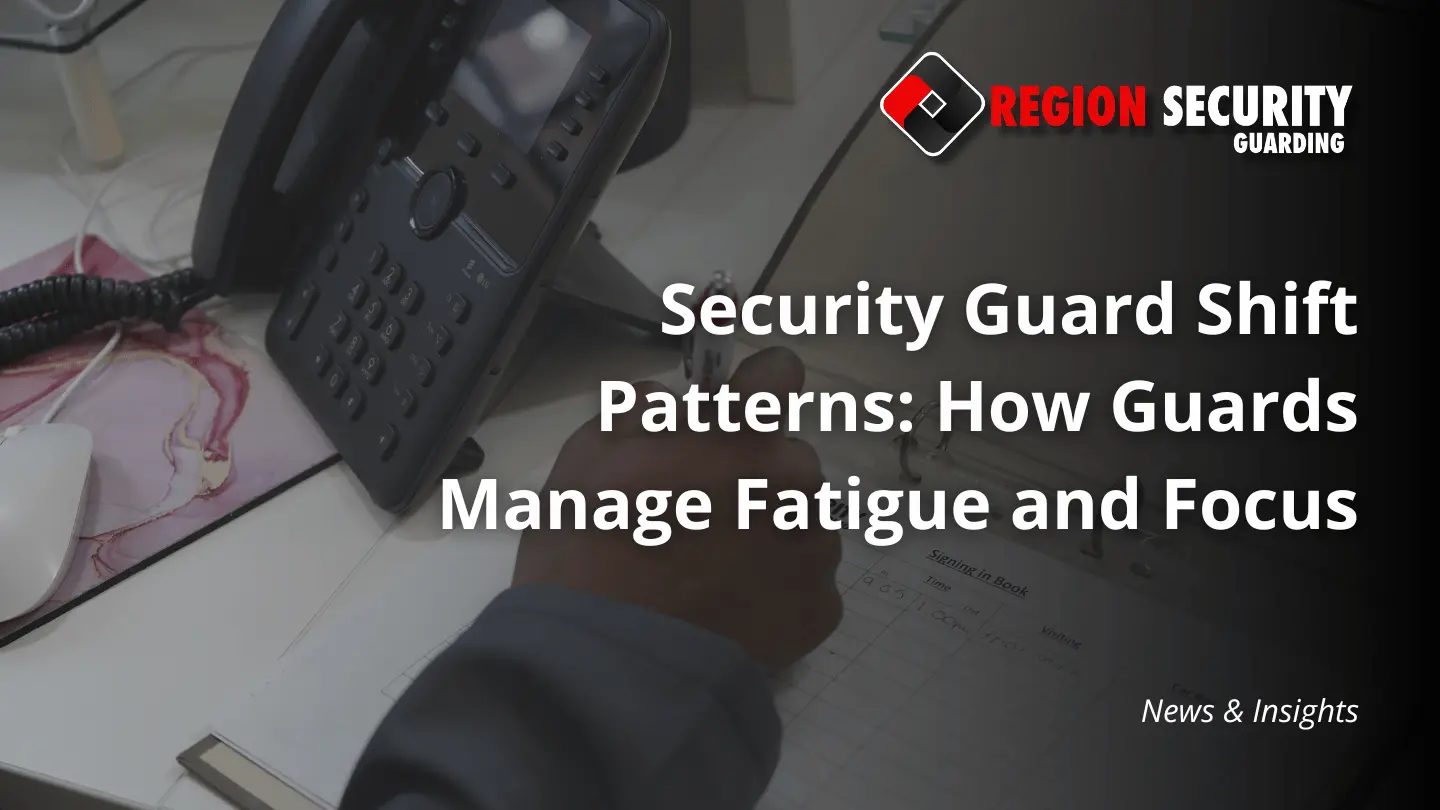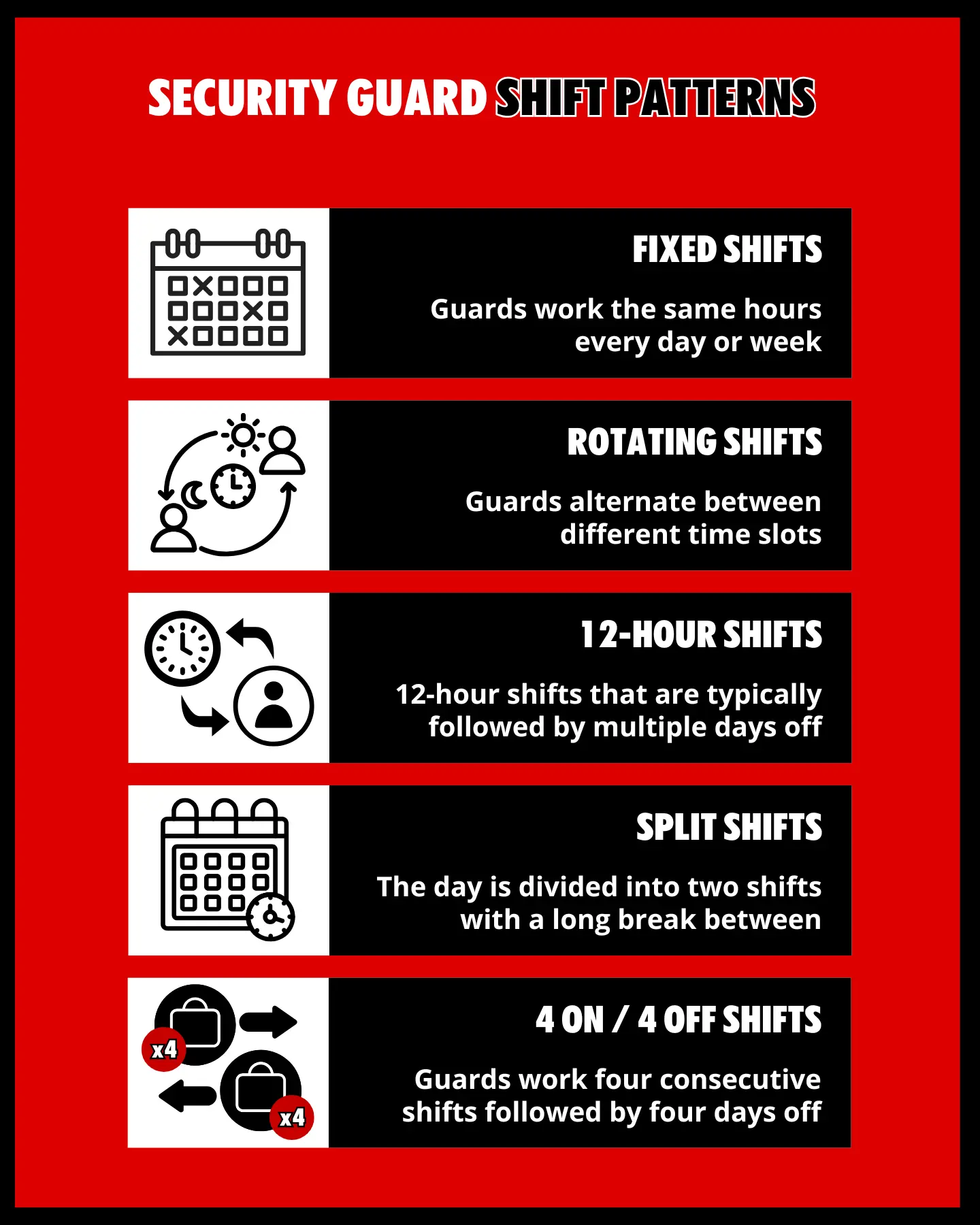Working as a security guard involves far more than simply being present on site. It’s a role that demands long hours, sharp focus, and constant awareness, often across varying shift schedules. Whether it’s a 12-hour shift, rotating pattern, or weekend coverage, the structure of these shifts can significantly impact a guard’s energy, wellbeing , and performance.
In this article, we’ll explore the most common security guard shift patterns used across the industry, their effects on mental and physical health, and the practical strategies guards use to stay focused and fight fatigue.
Table of Contents

Common Security Guard Shift Patterns
Security operations often run 24/7, meaning security guard shift patterns need to be carefully managed to ensure consistent coverage without burning out staff. Below are the most common security officer shift patterns seen in the industry, along with their pros and cons:
Fixed Shifts
Guards work the same hours every day or week, such as 8am-4pm or 10pm-6am.
Advantages:
- Encourages routine and better sleep habits
- Predictability helps with planning personal time
- Fewer disruptions to the body’s natural rhythm (especially for daytime shifts)
Disadvantages:
- Can become repetitive over time
- Night shifts may still disrupt sleep and social life
- Less flexibility to adapt to last-minute cover needs
Rotating Shifts:
Guards alternate between day and night security guard shifts across a week or month. This offers flexibility but can be disruptive to sleep patterns.
Advantages:
- More balanced distribution of less desirable shifts
- Encourages collaboration across different shifts
- Ensures full 24/7 coverage
Disadvantages:
- Makes it difficult to maintain consistent sleep or social routines
- Increased fatigue from switching body clocks
- Higher risk of burnout without proper rest between shifts
12-Hour Shifts
A popular option for manned guarding shift schedules, the 12-hour shift usually runs 7 am–7pm for days, and 7 pm–7 am for nights. This provides straightforward security shift structures that rotate between day and night cover.
It’s often followed by multiple days off.
Advantages:
- Fewer workdays in the week
- Longer rest periods between shift blocks
- Suitable for sites requiring fewer handovers
Disadvantages:
- Can be physically and mentally demanding
- Fatigue may increase towards the end of long shifts
- Less flexibility for emergencies or personal obligations
Split Shifts
The day is divided into two work periods, such as 6am-10am and 4pm-8pm, with a long break between.
Advantages:
- Ideal for covering peak business hours
- Can suit specific personal routines
- Reduces overstaffing during quiet periods
Disadvantages:
- Double commutes increase travel time and cost
- Long breaks may feel disruptive rather than restful
- Energy levels can dip before the second part of the shift
4 On / 4 Off Shifts
Guards work four consecutive long shifts (usually 12 hours), followed by four days off.
Advantages:
- Consistent and predictable rotation
- Extended time off for recovery or personal activities
- Well-suited for round-the-clock coverage
Disadvantages:
- Consecutive long shifts can be exhausting
- Missed weekends or public holidays due to cycle
- Tough on sleep if alternating between days and nights

The Impact of Shifts on Fatigue
Fatigue is one of the most pressing challenges security guards face. Long hours, irregular patterns, and overnight work can all take a toll on physical stamina and mental sharpness.
Night shifts in particular, can disrupt sleep schedules, making it harder to get high-quality rest during the day, which can quickly lead to:
- Decreased alertness and slower reaction times
- Difficulty concentrating or remembering tasks
- Increased stress, irritability, and even burnout
Add in factors like inconsistent meals, limited sunlight, and fewer social interactions, and it becomes clear how important fatigue management is for guards on all security guard working hours.
How Guards Stay Focused on the Job
Despite these challenges, many security professionals develop healthy habits and routines that help them maintain focus on the job. No matter the security guard shift patterns they’re working, these strategies can make a big difference:
- Stick to a Sleep Schedule: Even if shifts rotate, going to bed and waking up at similar times can help reset the body’s clock. Blackout curtains and white noise machines are useful for daytime sleep.
- Stay Hydrated and Eat Smart: Regular water intake and balanced meals improve alertness. Avoid heavy meals late at night, which can make you feel sluggish.
- Take Short, Regular Breaks: Brief pauses every few hours help maintain energy and prevent mental fatigue. Walking, stretching, or getting fresh air are simple but effective.
- Keep Mentally Engaged: Switching up tasks, patrolling regularly, and staying connected with colleagues can prevent boredom and drowsiness, especially on quieter shifts.
Support from Employers
Employers play a vital role in helping guards manage the demands of security guard shift patterns and shift work. Providing fair and predictable scheduling allows guards to plan their rest and personal time effectively, while ensuring adequate breaks and downtime between shifts helps prevent burnout. UK law requires at least 11 hours of rest between working days.
A comfortable work environment, including access to basic facilities, shelter, and rest areas, can make a significant difference during long or overnight shifts. Training on topics like fatigue management, sleep health, and stress reduction also supports guards in staying alert and focused.
Just as importantly, fostering open communication and encouraging staff to raise concerns without fear promotes a healthier, more responsive workplace.
Tools and Technologies That Help
Modern technology has introduced valuable tools to make shift work more manageable. for example, rota planning software ensures fair shift distribution and helps prevent overworking. Alternatively, lone worker devices, such as GPS trackers or panic buttons, provide safety and reassurance during isolated shifts.
Fatigue monitoring tools and mobile apps for real-time reporting can keep guards more engaged and alert throughout their duties. Internal communication platforms and health-focused apps also play a role in promoting wellbeing, helping guards stay connected, informed, and supported both on and off the clock.
Final Thoughts on Security Guard Shift Patterns
Security guard shift patterns are a core part of the industry. But it brings real challenges that can affect energy, alertness, and overall health. Understanding the impact of different shift types and taking steps to manage fatigue is key for both guards and employers.
If you’re a security guard, building healthy habits and communicating openly about your needs can help you perform at your best. And if you’re an employer, providing the right tools, training, and support systems is essential for maintaining a strong, focused team.
And, if you need dependable, well-supported guards for your business, don’t hesitate to get in touch with our team today. We provide professional, alert, and well-managed security staff for businesses of all sizes.
Business Security You Can Rely On
Trusted by leading businesses nationwide for reliable, 24/7 protection.
or call 0330 912 2033

We have used Region security for quite a while now. Top notch service, great guards and helpful staff. We love our guards and the team for all of their help / work.
No need to try the other companies at all.”
Andy Yeomans – Jones Skips Ltd
Great company, professional services, friendly guards and helpful at times when required.”
Rob Pell – Site Manager
A professional and reliable service. Always easy to contact and has never let us down with cover. No hesitation in recommending and competitively priced also.
After using an unreliable costly company for several years it is a pleasure to do business with Region Security”
Jane Meier – Manager
Region Security were very helpful in providing security for our building. We had overnight security for around 4 months. The guards themselves were professional, easy to reach and adapted very well to our specific needs. Would definitely recommend Region for security needs.
Lambert Smith Hampton
Great service. Reliable and professional and our lovely security guard Hussein was so helpful, friendly but assertive with patients when needed. He quickly became a part of our team and we would love to keep him! Will definitely use this company again
East Trees Health Centre
Fantastic Service from start to finish with helpful, polite accommodating staff, we have used Region Security a few times now and always been happy with what they provide.
Leah Ramsden – Manager




